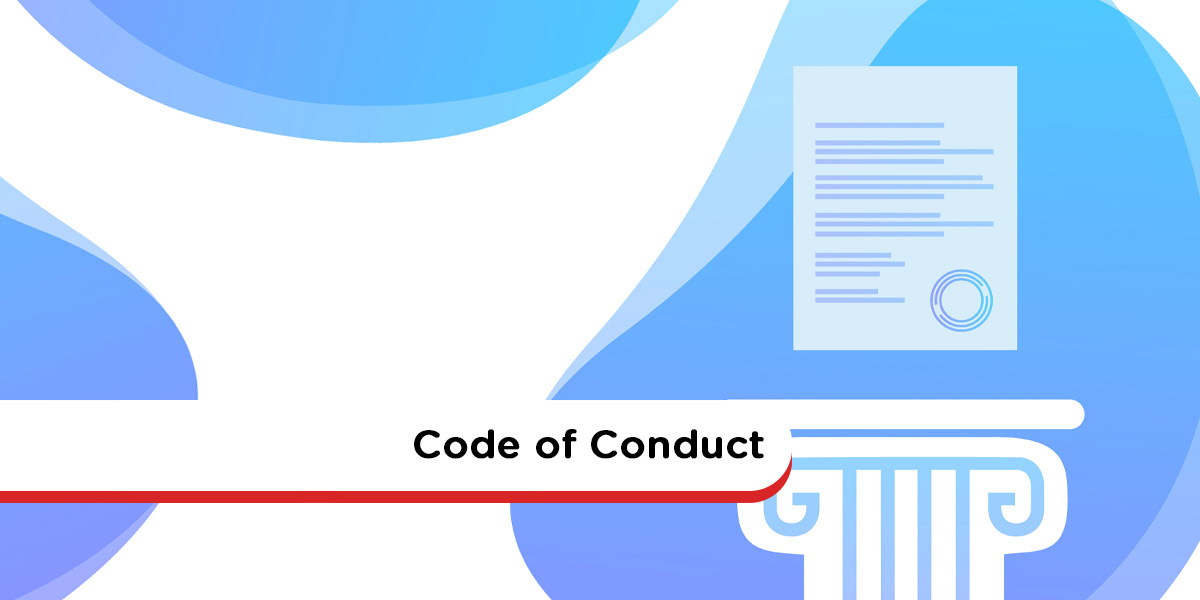
Your New Intranet Starts Here
Streamline communication, boost collaboration, and empower your team with MyHub's intuitive intranet solution.
Book a live demo now and experience the difference.
Take a Quick TourWhen it comes to maintaining good corporate governance, an employee code of conduct is essential, regardless of your organization’s size. This key document outlines the standards of workplace behavior and removes any ambiguity around expectations. Rooted in your company’s core values, a code of conduct also reflects and reinforces the organizational culture.
In this post, we explore the critical components of a well-crafted employee code of conduct. You’ll learn about the benefits of having a written policy and the steps required to create your own. Plus, we provide a ready-to-use code of conduct template you can customize to reflect your business values.
What Is a Code of Conduct in the Workplace?
An employee code of conduct is a formal document that outlines a company’s values, mission, and expectations for workplace behavior. It serves as both a behavioral guideline and a compliance tool and is often included in the employee handbook.
This code helps team members clearly understand what’s expected of them and outlines the consequences of any misconduct or violations. It is particularly valuable for onboarding new employees, offering guidance on what’s considered appropriate behavior within your organization.
A code of conduct also plays a vital role in a company’s compliance strategy and legal framework. While public organizations in the U.S. are legally required to have one, it’s equally good practice for nonprofits and private companies of all sizes.
Why Is a Code of Conduct for Business Important?
A code of conduct is a written commitment to ethical behavior and self-regulation in business. It strengthens your brand reputation and brings a host of practical benefits for your team and organization. Let’s break them down:
Clear and Transparent Expectations of Employee Behavior
Having a documented policy ensures that all employees understand how to act professionally. It also makes it easier to handle challenging situations or difficult colleagues when you have clearly defined behavioral standards.
Sets Benchmarks for Measuring Employee Performance
A code of conduct provides measurable benchmarks for evaluating employee actions and decisions. This allows managers to assess performance fairly and empowers employees to self-regulate their conduct in line with company policies.
Promotes the Company’s Culture
A code of conduct reinforces your company culture by clarifying your values and expected ways of working. It helps employees feel aligned with your standards and purpose. This alignment boosts employee engagement, improves retention, and supports ethical hiring practices.
Moreover, it shows external stakeholders, customers, and investors that your company takes integrity and professionalism seriously.
What Should Be in an Employee Code of Conduct?
While your business may have unique values and expectations, a good employee code of conduct typically includes these core elements:
- A clear statement of your company’s mission
- A summary of your company’s values and ethics
- Detailed guidelines on expected workplace behavior and etiquette
- Standards for customer service and interactions with external or internal stakeholders
- Relevant policies on harassment, bullying, discrimination, and workplace safety , such as your Workplace Harassment Policy
- Reference to industry-specific rules, regulations, and compliance standards
- Clear consequences for policy violations, including the disciplinary process
How Do You Write a Code of Conduct?
Creating an employee code of conduct should be a collaborative, thoughtful process. Typically, the HR department takes the lead, but involving senior leaders, managers, and employee representatives ensures well-rounded input.
Start by focusing on your people, write the code with their experience in mind. Avoid legal jargon; keep the language simple, direct, and easy to understand.
Also, review past workplace incidents or ethical breaches to inform your policy. Whether it was misuse of company resources or inappropriate behavior, these scenarios provide valuable lessons for prevention and guidance in your code.
Once a draft is ready, share it with employees for feedback. Their insights can help refine the policy and foster a stronger sense of ownership.
After finalization, make the document widely accessible. Store it on your company intranet or HR portal so employees can easily refer to it as needed.
What Is an Example of a Code of Conduct?
To help you get started, here’s a simple example of a code of conduct you can adapt for your business. This sample covers essential sections and reflects common best practices.
Code of Conduct Example for XYZ Company
This employee code of conduct applies to all XYZ employees, including full-time, part-time, and temporary staff.
The document reflects our commitment to professionalism, ethical conduct, and a positive workplace culture. It embodies our mission and values and guides employees on how to represent XYZ Company both internally and externally.
[Insert your company mission]
[Insert your company values and behavioral expectations]
Introduction
At XYZ Company, we take our code of conduct seriously and expect every employee to demonstrate the same level of commitment to maintaining a safe, respectful workplace. As outlined in all employment contracts, employees are required to follow the code of conduct while carrying out their job responsibilities.
If you have concerns about the behavior of colleagues or managers, or if you believe the code is not being upheld, we strongly encourage you to speak up. Reach out to your immediate supervisor or the human resources team for support and guidance.
The following sections outline the key rules and expectations outlined in our company code of conduct policy.
Compliance With the Law
Employees must act in accordance with all relevant local, state, and federal laws, including regulations on environmental practices, workplace safety, and fair business dealings. Uphold ethical behavior at all times, especially when handling company resources, property, and financial transactions.
Respect in the Workplace
XYZ Company maintains a strict zero-tolerance policy for discrimination, harassment, and bullying. All employees must comply with our equal opportunity and anti-harassment policies during every aspect of their work. [Include reference to your specific policies on sexual harassment, discrimination, and workplace bullying.]
Safeguarding Company Resources
Employees must handle all company property, from vehicles to laptops, with care and integrity. Misuse of office equipment, technology, or email addresses is strictly prohibited.
Additionally, employees are expected to protect the company’s intellectual property, including trademarks, copyrighted content, and other proprietary assets. Confidential information must be safeguarded in accordance with company data protection policies. Every employee plays a critical role in protecting both physical and digital resources from misuse, loss, or theft.
Professionalism at Work
Every employee is expected to demonstrate professional behavior and act with integrity in all workplace interactions. Professionalism encompasses a wide range of expectations, including the following:
- Personal appearance: All team members must follow the company’s dress code policy and maintain an appearance appropriate to their role.
- Bribery and corruption: Accepting gifts, bribes, or any form of unethical incentive is strictly prohibited under our anti-corruption policy.
- Conduct and working relationships: Treat all coworkers, customers, and stakeholders with respect and courtesy. Managers must not abuse their authority, and employees are expected to follow instructions from their supervisors.
- Employee tardiness and absenteeism: Employees should adhere to scheduled working hours and promptly report any absences. Unauthorized time off is not permitted. Use of accurate employee time tracking tools ensures accountability and supports workforce planning.
- Conflicts of interest: Any personal or financial interests that could impact job performance must be disclosed to a manager immediately.
- Team collaboration: Employees must work cooperatively to achieve shared goals. Disruptive or uncooperative behavior will not be tolerated.
- Communication: Follow the company’s internal communications policy to ensure messages are professional, clear, and respectful.
- Employment benefits: Misuse of benefits, including sick leave, vacation days, or company vehicles, is a violation of this policy.
- Policy compliance: Adherence to all company procedures and policies is mandatory. Contact HR or your supervisor if clarification is needed.
Industry Regulations
[Insert detailed information on any specific industry regulations or compliance requirements that apply to your business or sector.]
Code of Conduct Disciplinary Actions
XYZ Company reserves the right to take appropriate disciplinary action against employees who violate this code. Consequences depend on the severity and frequency of the violation and may include:
- Verbal or written warnings
- Reduction or suspension of employment benefits
- Demotion or reassignment
- Temporary suspension from work
- Termination of employment for serious or repeated offenses
In cases of serious misconduct, such as theft, fraud, corruption, or embezzlement, XYZ Company may also pursue legal action as required.
Note: This employee code of conduct template provides general guidance only and is not a legal document. It may not reflect all local, state, or federal legal requirements. MyHub disclaims all liability arising from the use of this document.
Code of Conduct vs. Code of Ethics – What’s the Difference?
The terms code of conduct and code of ethics are often used interchangeably, but they serve different purposes.
A code of ethics outlines an organization’s core principles, morals, and values. It provides a high-level framework to guide ethical decision-making and promotes the desired culture.
Meanwhile, a code of conduct offers specific, enforceable rules and expectations for employee behavior. It translates the broader ethics into concrete actions and compliance standards.
For instance, a code of ethics might encourage employees to act with kindness and respect. The code of conduct backs this up by detailing the types of respectful behaviors expected and outlining the disciplinary process for violations. Learn more in our Ethics in the Workplace Guide.
Employee Code of Conduct: Quick Summary
An effective employee code of conduct helps define acceptable workplace behavior and prevents misconduct, absenteeism, and unethical actions. It ensures employees know what’s expected, whether it’s adhering to the dress code, protecting company assets, or respecting colleagues.
Importantly, it also demonstrates your company’s commitment to ethical practices and transparent business operations. A well-communicated code of conduct supports your employer brand, attracts talent, and fosters employee retention.
Use our best-practice template as a foundation and tailor it to suit your company’s unique mission and values.
According to a recent study, 82% of employees believe a code of conduct or ethics improves their workplace environment, making it a powerful tool for employee engagement and organizational success.
About MyHub
MyHub is a trusted provider of cloud-hosted intranet software for organizations across industries. Our user-friendly platform brings together HR tools, policies, communication channels, and compliance resources, all under one digital roof. Designed by experts for non-technical users, MyHub makes it easy to build a modern, connected workplace.
Discover how we can support your business. Book a free demo or try us out with a 14-day free trial.
Stay ahead with more expert insights, subscribe to our blog for the latest trends in employee engagement, workplace policies, and digital transformation.
FAQ Section
What is a code of conduct in the workplace?
A code of conduct outlines your organization’s values, expectations for employee behaviour, and the consequences of breaches—it forms part of your compliance and governance framework.
Why is it important to have a written code of conduct?
A formal code provides clarity, helps prevent misconduct, supports consistent disciplinary actions, and fosters employee trust by setting transparent standards .
What are key sections in a good code of conduct?
Essential parts include mission and values, behavior guidelines (e.g., respect, honesty), conflict-of-interest rules, resource use policies, disciplinary procedures, and compliance with legal requirements.



